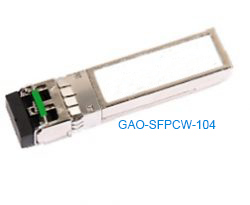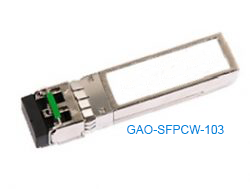Description
Key Features
- Up to 49.7 Miles(80km) on 9/125µm SMF
- Up to 155 Mb/s data links
- Compliant with SFF-8472
- DFB laser transmitter and PIN photo-detector
- Hot-pluggable SFP footprint
- Duplex LC/UPC type pluggable optical interface
- Low power dissipation
- Metal enclosure, for lower EMI
- RoHS compliant and lead-free
- Support Digital Diagnostic Monitoring interface
- Case operating temperature range from
Commercial: 32°F to 158°F (0°C to +70°C)
Extended: 14°F to 176°F (-10°C to +80°C)
Industrial: -40°F to 185°F (-40°C to +85°C)
- Single +3.3V power sup
Technical Specifications
| Protocol | 2-wire serial communication protocol |
| Standard | SFF-8472
IEC/EN 61000-4-2 FCC Part 15 Class B EN 55022 Class B (CISPR 22A) FDA 21CFR 1040.10, 1040.11 IEC/EN 60825-1,2 IEC/EN 60950 ,UL RoHS 2002/95/EC EN61000-3 |
| Working Range | Up to 49.7 Miles(80 Km) |
| Data rate | 155 Mb/s |
| Wavelength | CWDM |
| Transmitter Extinction Ratio | 8.2 dB |
| Transmitter Off Output Power | -45dBm |
| Transmitter Differential Line Input Impedance | 90-110 Ω |
| Receiver Sensitivity | -33dBm |
| Receiver Input Optical Wavelength | 1270-1610nm |
| Receiver Input Saturation Power(Overload) | -10 dBm |
| Supply Voltage | -0.5 to 4V |
| Dimensions | 2.29in*0.54in*0.33 in (L 58.4mm*W 13.9mm*H 8.5mm) |
| Relative Humidity | 5% to 95% |
| Storage Temperature | -40°F to 185°F (-40°C to 85°C) |
| Case Operating Temperature | 32°F to +158°F (0°C to 70°C) for Commercial use
14°F to 176°F ( -10°C to +80°C) for Extended use -40°F to 185°F (-40°C to +85°C) for Industrial use |
Product Selection
| Wavelength | Clasp Color code |
| 1270 nm | Gray |
| 1290 nm | Gray |
| 1310 nm | Gray |
| 1330 nm | Purple |
| 1350 nm | Blue |
| 1370 nm | Green |
| 1390 nm | Yellow |
| 1410 nm | Orange |
| 1430 nm | Red |
| 1450 nm | Brown |
| 1470 nm | Gray |
| 1490 nm | Purple |
| 1510 nm | Blue |
| 1530 nm | Green |
| 1550 nm | yellow |
| 1570 nm | Orange |
| 1590 nm | red |
| 1610 nm | Brown |
PIN Descriptions:


Notes:
- Circuit ground is internally isolated from chassis ground.
- Laser output disabled on TDIS >2.0V or open, enabled on TDIS <0.8V
- Should be pulled up with 4.7k – 10kohms on host board to a voltage between 2.0V and 3.6V.MOD_DEF (0) pulls line low to indicate module is plugged in.
- This is an optional input used to control the receiver bandwidth for compatibility with multiple data rates (most likely Fiber Channel 1x and 2x Rates).If implemented, the input will be internally pulled down with > 30kΩ resistor. The input states are:
- Low (0 – 0.8V): Reduced Bandwidth
- (>0.8, < 2.0V): Undefined
- High (2.0 – 3.465V): Full Bandwidth
- Open: Reduced Bandwidth
- LOS is open collector output should be pulled up with 4.7k – 10kohms on host board to a voltage between 2.0V and 3.6V. Logic 0 indicates normal operation; logic 1 indicates loss of signal.
Electrical Interface Characteristics:

Note (1): A (TX) + B (RX) = 280mA (Not include termination circuit)
Digital Diagnostic Functions
GAOTek GAO-SFPCW-104 transceivers support the 2-wire serial communication protocol as defined in the SFP MSA. It is very closely related to the E2PROM defined in the GBIC standard, with the same electrical specifications. The standard SFP serial ID provides access to identification information that describes the transceiver’s capabilities, standard interfaces, manufacturer, and other information.
Additionally, GAOTek SFP transceivers provide a unique enhanced digital diagnostic monitoring interface, which allows real-time access to device operating parameters such as transceiver temperature, laser bias current, transmitted optical power, received optical power and transceiver supply voltage .It also defines a sophisticated system of alarm and warning flags, which alerts end-users when particular operating parameters are outside of a factory set normal range.
The SFP MSA defines a 256-byte memory map in E2PROM that is accessible over a 2-wire serial interface at the 8 bit address 1010000X (A0h). The digital diagnostic monitoring interface makes use of the 8 bit address 1010001X (A2h), so the originally defined serial ID memory map remains unchanged. The interface is identical to, and is thus fully backward compatible with both the GBIC Specification and the SFP Multi Source Agreement.
The operating and diagnostics information is monitored and reported by a Digital Diagnostics Transceiver Controller (DDTC) inside the transceiver, which is accessed through a 2-wire serial interface. When the serial protocol is activated, the serial clock signal (SCL, Mod Def 1) is generated by the host. The positive edge clocks data into the SFP transceiver into those segments of the E2PROM that are not write-protected. The negative edge clocks data from the SFP transceiver. The serial data signal (SDA, Mod Def 2) is bi-directional for serial data transfer. The host uses SDA in conjunction with SCL to mark the start and end of serial protocol activation. The memories are organized as a series of 8-bit data words that can be addressed individually or sequentially.
Digital diagnostics for the GAO-SFPCW-104 are internally calibrated by default.
Recommended Circuit Schematic

Regulatory Compliance

Mechanical Specifications

Applications
- Switch to Switch Interface
- Fast Ethernet
- Switched Backplane Applications
- Router/Server Interface
- Other Optical Links



